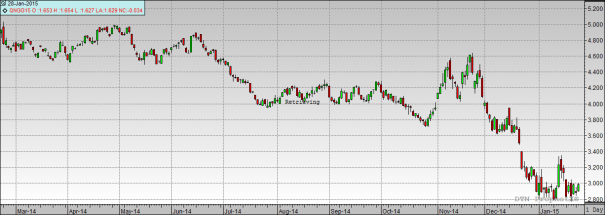Power Energy USA is located in Houston, Texas – “the Energy Capital of the U.S.” Power Energy is an energy broker which sells electricity and natural gas in deregulated U.S. markets, and it began in 2015 to sell solar energy throughout the world with its sister company – McLaren Solar, LLC.
My overall prediction is I am very worried the Houston economy will begin to weaken significantly in 2016, and will fall into a recession in 2017. Why?
The United States is awash in the two major energy commodities. We have too much oil and too much natural gas. Oil is an “international commodity” for this discussion as its price is heavily influenced by international events. Saudi Arabia has decided not to reduce its oil production even as oil prices collapse worldwide. They claim they do not want to lose market share, a legitimate argument, but they are also hurting their enemies like Russia and Iran without firing a single bullet. They are also trying successfully to hurt the U.S. fracking industry. As a bottom line item though – the new Saudi King’s first budget shows a $98 billion deficit so the country must keep pumping oil, no matter what the price. In fact, the Saudi-led OPEC has actually produced a record amount of oil in the past three months.
Natural gas, on the other hand, is much more an “American commodity” for this discussion. The price of natural gas is primarily focused on current U.S. weather patterns and the amount of gas in storage in the U.S. America produced 6.7% more natural gas in 2015 than 2014, and now has a record surplus of gas in storage.
Both oil (WTI) and natural gas face a slippery slope (pun intended) in 2016.
The Houston economy will suffer significantly from the ongoing collapse in the price of both oil and gas. Oil prices will continue to fall, more than likely down to the mid to high $20s as the Saudis will continue to pump their oil at record levels. Goldman Sachs has a more dire prediction. Their analysts feel oil will have to drop to $20 a barrel in order to get the significant cuts in WTI production required to get higher prices. (The weekly rig count only dropped three last week.)
Natural gas prices will remain at 15-20 year lows as we will continue to have record levels of gas in storage, more than likely pushing the upper limits of our total capacity by September-October. These low energy prices will lay open for the entire world and investors to see the management deficiencies of many of our local energy companies.
Let me highlight a few starting with Kinder Morgan, the Houston-based pipeline company. Analyst Kevin Kaiser of Hedgeye called Kinder Morgan “a house of cards” in September, 2013. For the past two years Mr. Kaiser has taken a great deal of heat for his analysis of the company as well as his “house of cards” statement. Ladies and Gentlemen – he may have been very accurate in his critical remarks regarding Kinder’s management. In 2013 Mr. Kaiser said, “I think there are some very misleading statements with some of the non-GAAP financials,” and he did not think “Kinder Morgan’s stock is safe for investors.” How soon investors forget the financials of Enron.
At that time in 2013 13 analysts had “BUY” ratings on the stock and 6 others recommended “HOLD” ratings. Mr. Kaiser recommended a short position in the stock. No one else had a sell recommendation. Kinder’s stock traded in the $40 range with a high in 2015 of $44.71 before it dropped to a low of $14.22, a 68.2% plunge, when the company finally stopped borrowing more and more money to pay its dividend, one the concerns Mr. Kaiser had also pointed out. The company also lowered its dividend 75% and the stock collapsed. Jim Kramer on CNBC staunchly defended the company right up until the stock price collapsed. Kevin Kaiser of Hedgeye was the only analyst to see this clearly two years ago. Investors who followed the Hedgeye recommendation and shorted Kinder Morgan made money generally. Kinder still trades at a ridiculously high PE ratio of 31 today. (2015 close = $14.92) Buyer beware…
With low interest rates savers have been looking for higher returns on their money so many went into the stock market and invested in “safe” high dividend paying stocks. This helped push stock prices up to new highs over the past few years. Many energy companies in the Houston area fit this model. They continue to pay relatively high dividends compared to the market even as commodity prices collapse. Some have gone into the bond market to BORROW the monies only to pay their unrealistic dividends, like Kinder Morgan, because they know their stock prices will fall, like Kinder’s, if they cut the dividend.
Conoco Phillips, and others, have continued to borrow hundreds of millions of dollars in order to pay a fat dividend to shareholders. Conoco’s yield currently is a hefty 6.44% when they have NO EARNINGS. Management again is kidding themselves into believing oil prices will go up soon. We have a lot of horse manure in Texas and so many companies in Houston keep shoveling it to their investors. These policies lead to devastating results for their investors and employees. Conoco Phillips had a high share price of $70.79 per share in 2015, and they did not have any earnings. THEY DID NOT MAKE MONEY. (2015 close = $46.69) Buyer beware…
Up in Oklahoma City Chesapeake Energy will probably default on their debt soon after that company has been so poorly managed over the years. Chesapeake’s stock had a high this year of $21.49 (what were those folks smoking at the time?) and a low of $3.56. (2015 close = $4.50) Buyer beware…
NRG Energy was a power generation company in 2007 with several electricity generation plants in the Houston area. It is now headquartered in Princeton, NJ, and Houston, TX. When deregulation of the Texas electricity market took effect in 2002 the utility monopoly in Houston, Houston Lighting & Power (HL&P), was broken up into three separate companies – Reliant Energy (the retail customers), Texas Genco (the power generation), and CenterPoint Energy (the pole & wires). NRG Energy bought Texas Genco from a group of private equity firms in late 2005 for roughly $5.9 billion. NRG Energy acquired the “Reliant” name and the customer list of Reliant Energy in May 2009 when Reliant basically went bankrupt after the third quarter of 2008 owing NRG upwards of $2 billion for power they purchased from the generator.
In November, 2010 NRG extended its retail customer footprint with the acquisition of Green Mountain Energy. In March, 2015 NRG extended its retail market further with its acquisition of Cirro Energy from Virginia-based Dominion Resources. Other acquisitions included the roll-up of two bankrupt power generation companies, called GenOn Energy, in December, 2012 for $1.7 billion. In August, 2013 NRG acquired Energy Curtailment Specialists, a Buffalo, NY-based “Demand Response” company (terms were not disclosed). In September, 2014 NRG acquired GoalZero, a manufacturer of personal solar power products.
Borrowing all of these billions of dollars in order to produce and sell electricity primarily in the Texas market which already has the lowest cost electricity rates in America finally caught up with the rapidly expanding NRG. My understanding is the Green Mountain Energy division is hemorrhaging cash at the moment. In September, 2015 Wall Street forced NRG to spin off all of its “clean energy” assets into a new public company, “GreenCo”, which was scheduled to begin trading in January, 2016. (Wall Street loves fees, fees, and more fees…) David Crane, CEO and the architect of all of the forward-thinking clean energy diversification, was let go (fired) by NRG on December 3, 2015. NRG Energy had a loss in 2015, but the stock had a high of $28.39. Normally when the CEO leaves a company whose stock is falling the stock generally takes a jump upward on the announcement. Instead NRG’s stock fell to a new yearly low of $8.80. Not a good sign.
It may be a good idea to track the new “GreenCo” stock in 2016, but it is my understanding now in the last week of December the key investor/private equity firm on this deal has pulled their support, and “GreenCo” may not launch soon. Another very poor sign.
CenterPoint Energy does trade on the NYSE and is the monopoly now in the Houston electricity market. CPE has quietly raised its prices per kWh for its poles & wires fees by 80% over the past ten years. The highly leveraged NRG Energy stock should be avoided until oil and gas prices reverse their downward projection, and we have had a chance to evaluate the new management team. I am not optimistic. (NRG 2015 close = $11.77) (CPE 2015 close = $18.36) Buyer beware…
2016 Predictions:
The Saudis will continue to pump oil in order to hurt their enemies and competitors (sometimes one in the same…). Oil prices will continue to drop and many Texas oil & gas companies will be forced into bankruptcy (22 filed in 2015/36 companies overall). 70,000 oil jobs were lost in the U.S. in 2015, and more will be lost in 2016 & 2017. Nine companies filed for bankruptcy protection in just the fourth quarter of 2015, and they alone had over $2 billion of debt.
The “El Nino” weather pattern this winter will keep colder weather out and warmer weather dominant in the northern U.S. (72 degrees in NYC for Christmas Eve…) so we will continue to build a surplus of natural gas in storage. Two of the smallest drawdowns from gas storage in any December since they have kept records have taken place these past two weeks this year. We will run out of storage capacity in September or October if the pace of production continues with an expected increase of another 1.5% in 2016. Do we just give gas away then?
My predictions –
Oil (WTI): $25 – $28 p/barrel low (2015 close = $37.04);
Natural Gas: $1.35 – $1.50 p/contract low (2015 close = $2.337);
Gold: $1,175 – $1,200 p/oz. high (2015 close = $1,059.10)
Dow Jones (DJIA): 15,400 – 15,600 low (2015 close = 17,425.03);
S&P 500: 1,800 – 1,825 low (2015 close = 2,043.94);
NASDAQ: 4,250 – 4,500 low (2015 close = 5,007.41);
Junk Bonds: Many energy companies borrowed money heavily for fracking and exploration when oil was $75 per barrel or higher. Many investors looking for a higher yield on their money invested in “high yield bond funds” which generally invest in risky junk bonds. Somewhere between 15% – 20% of all junk bonds are in the oil & gas industry. We will see a significant number of these bonds default in 2016. Several bond funds closed their doors to redemptions shortly after the Federal Reserve raised interest rates even slightly because of the lack of bids to buy their bonds. Buyer beware…
ENRON look-a-like: SunEdison (Beware of financials that do not make sense…) (2015 close = $5.09)
I have not painted a real positive picture for the markets in 2016. If you like to drive your car you will have plenty of cheap gas. Your electricity rates in Texas will be the lowest in the U.S. and the lowest in 15 years.
Otherwise, fasten your seat belts. Pull those shoulder harnesses tight. The Federal Reserve has once again contributed to building “bubbles” in stocks, housing prices, and things like art pieces. Remember what happened in 2007 – 2008 when these bubbles burst the last time. Remember back to the mid-1980’s in Houston, Dallas and Oklahoma City. We will see a significant slowdown, probably a recession, in Houston soon.
In the stock market – there was no reason for anyone to buy Chipolte Mexican Grill stock at more than $750 per share. With its recent collapse it still trades at an unrealistic 29.5 PE ratio. (2015 close = $479.85) How can Tesla trade above $240 per share when they lose money on every car they sell? Do they make it up in volume? (2015 close = $240.01) Buyer beware…
Best wishes and good luck in 2016.
Doug Mathes
Power Energy USA


